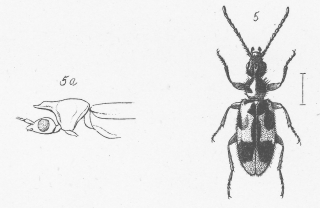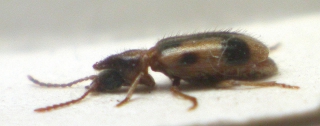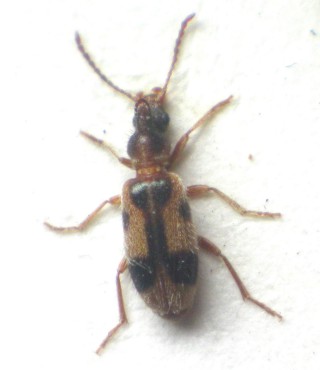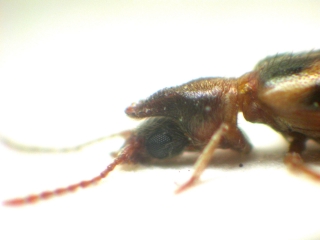Worcestershire Record No. 19 November 2005 p. 38
Harry Green
On the 18th June 2005 visit to Cherry Orchard, Worcester, John Meiklejohn swept several of these small beetles (about 4 mm long) from vegetation. The RECORDER data base states: A small black and brown beetle with a prominent 'horn' projecting forward from the thorax over its head. Lives in short turf and among strandline litter on sand dunes. Widely distributed on dunes around the British coast and occasionally found inland on sandy heathland. John also found the species on the same site 28th August 2000 while undertaking earlier survey work.
We had little information about the species. Fletcher (1901) published a list of beetles found in Worcestershire in the Victoria County History and stated “The species [of Coleoptera] found here hitherto number about a thousand. The following list includes the less common species only”. Notoxus is not in the list so we cannot tell whether it had not been found or it was too common to list! In the literature I have to hand Andrew Duff (1993) says that the species is “Resident. Local; at plant roots on sandy soils” in Somerset. Tomlin (1949) states “Banks of the Monnow, Moccas.” in a list of Herefordshire beetles.
Rye & Fowler (1890) write “Notoxus monoceros, an elegant, downy, little species, very variable in its markings, occurs plentifully in sandy places, both at the seaside and inland. The thorax is produced in the middle into a stout horn, which projects over the head”. Fowler (1891) writes “Sandy places; at roots of grass, in moss etc, both inland and on the coast; somewhat local, but not uncommon and widely distributed … … I have found it on sandhills near the sea”. Amongst the sites he lists are Kidderminster and Bewdley. Jon Cooter (pers comm.), from Herefordshire, tells me of an old record at Hartlebury Common in Worcestershire, annotated by G H Ashe into his copy of Fowler (1891): "Hartlebury Common, not rare, once found in abdomen of dead Meloe" This fits with the comment in Harde (1998) on Anthicidae that “Most species live in decaying vegetable matter and subsist chiefly on dead beetles”.
Because of the paucity of information I placed an enquiry on the Coleopterist’s egroup. Several helpful responses have partly clarified the modern situation. The beetle appears to be found most often in dry sandy places and these are not necessarily on the coast although coastal records are not infrequent. It has been found quite frequently on the Brecklands in East Anglia including set-aside fields, and it is suggested that it often frequents early successional vegetation on sandy soils in many parts of England. Other records do come from coastal sites but others are inland, sometimes on clay soils. Hartlebury is of course a very sandy place. It has also been suggested that a search along the Severn on suitable soils may well reveal a wider distribution.
So far I have not been able to discover much about the life cycle and natural history of Notoxus monoceros. Web search has produced some rather abstruse science but no straightforward accounts.
There is something of a challenge here! Can we find more sites for this beetle in present-day Worcestershire? There are still plenty of suitable sandy areas in the Kidderminster district including heathlands, although such areas are less common than in Fowler’s day. There are also many sand or gravel terraces along the Severn, Avon and Teme valleys although perhaps modern cultivation probably makes many of these sites unsuitable.
Although this beetle is very small it is striking in appearance and relatively easy to identify, so keep a look-out!.
Acknowledgements
Many thanks to members of the Coleopterist eGroup who provided information.
References.
| DUFF A 1993 Beetles of Somerset. Somerset Archeological & Natural History Society. | |
| FLETCHER, JE 1901. Insects. Coleoptera. The Victoria History of the Counties of England: Worcestershire. Volume 1 page 96-100. Constable: London | |
| FOWLER WW 1891 The Coleoptera of the British Isles. Vol 5. Reeve: London | |
| HARDE KW 1998 A Field Guide in colour to beetles. Blitz edition. See also older Octopus edition. | |
| RYE EC & FOWLER WW 1890 British Beetles. An introduction to the study of our indigenous coleoptera. Reeve: London | |
| TOMLIN J R le B 1949. Herefordshire Coleoptera. Woolhope Naturalists Field Club. |
 |
 |
| Notoxus monoceros Drawing from Rye & Fowler 1890. The line drawing on the left show the pronotal projection. Actual size about 4 mm long front of head to end abdomen. | Notoxus monoceros. Specimen in John Meiklejohn’s reference collection. Note the forward projection(“horn”) on the pronotum. |
 |
 |
| Notoxus monoceros. Specimen in John Meiklejohn’s reference collection. Note the forward projection(“horn”) on the pronotum. | |
| WBRC Home | Worcs Record Listing by Issue | Worcs Record Listing by Subject |